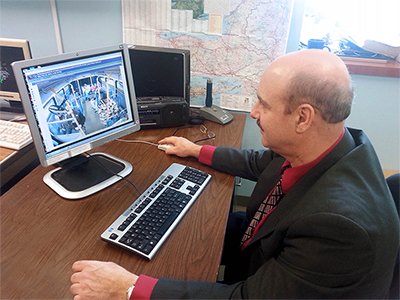The Capital District Transportation Authority (CDTA), serving the New York State capital city of Albany and surrounding counties, has seen an 80 to 90 percent decrease in liability claim payouts since deploying a video surveillance system in 2007.
"With video evidence from mobile network video recorders installed on about 150 of the transportation authority’s fixed route buses, investigators sometimes discover that people claiming sore necks and backs from an abrupt stop or fall don’t always accurately report what happened,” said Rick Vines, CDTA’s director of risk management. “The video surveillance system has exceeded my expectations as well as the expectations of the whole management team.”
of risk management. “The video surveillance system has exceeded my expectations as well as the expectations of the whole management team.”
A fixed video surveillance system also captures activity at several bus garages, an administrative and call center facility and a train station all owned and operated by the transportation authority. The busy Rensselaer Rail Station, equipped with six recorders and approximately 100 cameras, serves Amtrak’s Lakeshore Limited, which offers daily service between Chicago and Albany with connections to Boston and New York City. One of the busiest commuter stations in the U.S., Rensselaer, also serves Amtrak routes connecting New York City, Toronto and Montreal.
The combined wayside and mobile video surveillance system consists of approximately 170 March Networks mobile and fixed hybrid network video recorders (NVRs) and 1,500 cameras.
CDTA’s fixed route buses are typically equipped with eight cameras — one on the dash covering the road, two mounted on the exterior covering side views, and five cameras recording events at the fare box, the front and back doors and the interior of the bus. Two microphones per bus also record audio at the driver’s station and at the rear door.
In the event of a reported incident involving a CDTA bus, CDTA’s Risk Management Director and/or Safety and Operations staff use video management software to retrieve the video clip(s) required to investigate the incident. The process for this starts by indicating the date and time, as well as the bus, on which the incident is alleged to have occurred. When the bus returns to one of CDTA’s three garages and is within range of a wireless hot spot, the requested video is automatically downloaded to the server.
The video surveillance system provides evidence for the review of liability claims along with the usual safety and security issues. It’s also effective as a deterrent and is a great training tool, especially for bus operators.
“In the event of a security issue, we’re able to access video to determine exactly what happened,” said Vines. “In one case several years ago, for example, a student fired a pellet gun at one of our buses. No one was hurt, but a window was damaged and had to be replaced. The video enabled us to get a good image of the person, and we were able to identify him and work with the school district to hold him accountable and get restitution.
“The video surveillance system also helped us to identify a passenger who made a continual habit of boarding a bus and refusing to pay. After several failed attempts to get him to comply, we ultimately posted his image internally and suspended him from using our services.”
The mobile video recorders have sufficient internal storage to ensure the availability of video evidence following an incident.
A technologically-progressive organization, CDTA is currently upgrading its video surveillance systems with the addition of IP cameras on its buses and in its facilities. It’s also replacing wayside legacy recorders with new 8000 Series Hybrid NVRs.
A new order of fixed route buses scheduled to join the fleet later this year will be equipped with new RideSafe GT Series Hybrid Transit NVRs. The GT Series recorders come in 8, 12, 16 and 20-channel models, allow for a transition from 100 percent analog to 100 percent IP video, and are managed using enterprise video management software.
With the transition to the new mobile and fixed NVRs, CDTA will be able to manage its entire video surveillance system using the same video management software platform and continue the transition to IP video over time as budgets allow.
In keeping with its commitment to leading-edge technology, CDTA has also introduced a mobile app that allows passengers to access real time route information, schedules, service advisories and maps on their smartphones. They can plan their trip and find out when their bus is coming.
“Our record ridership of 16.5 million in 2014 is definitely attributable to the emphasis we place on passenger safety and convenience,” said Vines.
Last year, CDTA received a Gold Standard rating from the U.S. Department of Homeland Security’s Transportation Security Administration (TSA).
The TSA’s Baseline Assessments for Security Enhancements program ranks a transportation authority’s security plans and systems, training and public outreach efforts, and identifies opportunities for improvement.
CDTA was one of only six mass transit agencies in the U.S. to qualify for the Gold Standard rating for 2013